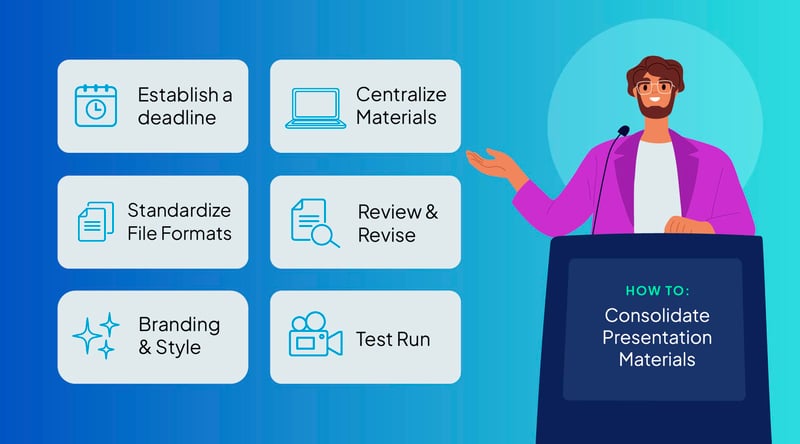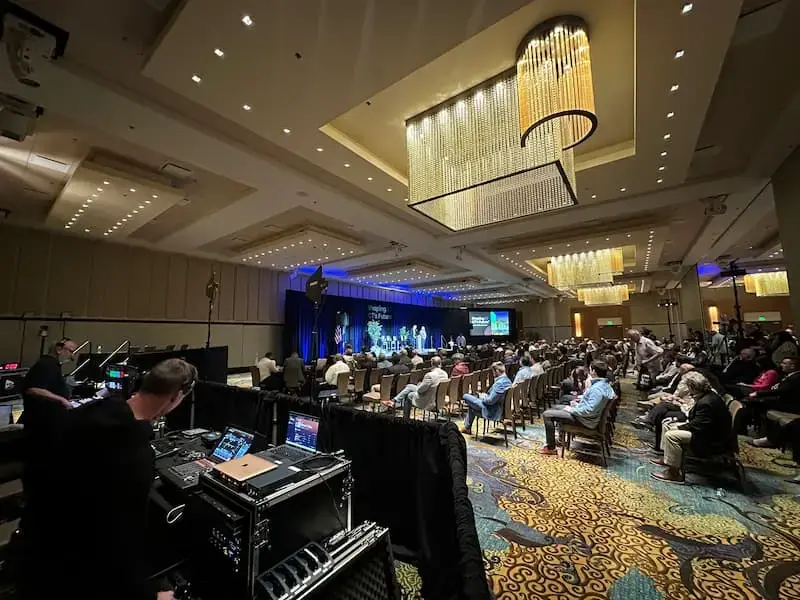Imagine you're standing in the wings of a grand auditorium. The room is alive with anticipation and you can sense the eagerness of the audience as they await the keynote speaker. You watch the speaker take a deep breath and then calmly step onto the stage. As the light spotlights them, they’re a picture of confidence. They’re ready, not just to give another presentation, but to truly inspire.
But how did you, the event organizer, facilitate this moment of poised professionalism? It definitely wasn't a stroke of luck. It was the result of your meticulous planning behind the scenes—from detailed preparation to comprehensive rehearsals. Today, you're not just overseeing an event; you're the maestro of a symphony, ensuring every note and pause of the presentation is harmonized and intentional.
Creating an environment where speakers can truly shine is an art, one that requires insight, precision, and an understanding of the nuances of live events. In this blog, we'll share three often overlooked yet crucial tips that event organizers can use to elevate speaker presentations and deliver truly memorable events.
Let’s dive into tip number 1…
Tip 1) Create A Clear Run-of-Show Plan
Have you ever been part of an event that felt disjointed and a little chaotic? An event where you can feel the stress and pressure around you, and it’s not just the nerves of the big show. Chances are it lacked a clear run-of-show plan or the run-of-show plan wasn’t effectively communicated to all stakeholders. Either way, there's a simple solution.
A run-of-show plan is essentially the blueprint of your event. It’s your go-to for everything. Whether you’re the host or a guest speaker, with live events, things are constantly moving and changing, that’s why a well-structured run-of-show is your anchor. It provides a clear roadmap for you and all stakeholders involved, from technicians to presenters and catering, allowing for efficient coordination and timely execution.

By locking in a clear run-of-show early and communicating it to everyone involved, you can create a unified vision for the event. This not only helps in aligning all the moving parts but also allows ample time for rehearsals and run-throughs, reducing last-minute hiccups and stress.
How to craft an effective run-of-show plan
To create an effective run-of-show plan, chronologically break down the event into segments—introduction, keynote speeches, panel discussions, Q&A sessions, breaks, and closing remarks. For each segment, specify the timing, cues, the responsible person, and any special requirements like audio-visual aids or stage setups.
Remember, clarity, detail and communication are key for this to work effectively and reduce day-of-event stress. The more precise your run-of-show, the smoother your event will flow.
Click here to download a run-of-show plan template for free (no email needed).
Tip 2) Mastering The Art Of Event Rehearsals
Now we’re moving to the opposite end of the event cycle–the rehearsals. This is where the magic of a live event begins to take shape. It's where ideas are tested, refined, and polished. But what is an event rehearsal and why is it so crucial for both organizers and presenters?
An event rehearsal is a full run-through of the event or presentation with all stakeholders involved. But it’s more than just a run-through of what's going to happen. It's an opportunity to fine-tune every aspect of the presentation, from the timing of each segment to the technical details like lighting and sound. For presenters, it's a chance to get comfortable with the stage, the audience layout, and the flow of their content. For organizers, it's about ensuring that every element of the event aligns perfectly with their vision.
Good conductors know when to let an orchestra lead itself. Ninety percent of what a conductor does comes in the rehearsal—the vision, the structure, the architecture
—Joshua Bell
Tips for running effective event rehearsals
Rehearsals uncover potential challenges and provide time to make corrections well before they can be called “problems”. Rehearsals allow everyone, from presenters to crew, to familiarize themselves with their roles, responsibilities and cues. They also provide a safe space to make a mistake, be it a technical glitch or a timing mismatch, and correct it without a live audience.

Here are some tips from our team to help you run an effective rehearsal session:
-
Pre-Rehearsal Preparation: Before the rehearsal, ensure that all participants have a clear understanding of the run-of-show and rehearsal requirements. Share scripts, schedules, and any other relevant materials in advance so participants can review their parts and come prepared with questions or concerns.
-
During the Rehearsal: Start by walking everyone through the run-of-show. Pay attention to transitions between different segments and ensure they are smooth. For presenters, practice your speech with the actual audio-visual aids you'll be using. For organizers, coordinate with the tech team to test all equipment and troubleshoot any issues.
-
Post-Rehearsal Review: After the rehearsal, gather feedback from all participants. Discuss what worked well and what needs improvement. This is also the time to make any final adjustments to the run-of-show or the presentation materials.
Remember, the goal of a rehearsal is not just to practice but to perfect and build everyone’s confidence. Whether it's a full dress rehearsal or a more casual run-through, integrating rehearsals can make a significant difference in the overall quality and success of the event.
Tip 3) Reduce Stress By Consolidating Presentation Materials
When it comes to managing presentation materials, less is more, and preparation is key. Consolidating presentation materials is often overlooked but can be a game-changer in ensuring a smooth, stress-free, and professional experience for both presenters and attendees.
This step might seem straightforward, but it's a task that requires consideration and coordination–especially when dealing with multiple speakers. Each presenter might have their unique style, format, and requirements for their slides or videos. However, the challenge lies in bringing these diverse elements together into a cohesive presentation since every presenter wants independent control!
Consolidating presentation materials is also crucial as it streamlines the technical aspects of the event. Having all materials on a production-controlled computer (always with a live backup!) reduces potential technical issues with changing computers between decks. It also facilitates smoother transitions between speakers, as the technicians can easily navigate through one comprehensive deck with a click, instead of juggling multiple files during a live event.

Here are some quick tips to help you consolidate presentation materials:
- Establish a deadline: get all final materials with enough time for the team to load it and test it.
- Standardize File Formats: PowerPoint and Keynote are the two most popular file formats.
- Branding and Style: Company meetings should use common layouts.This could include font sizes, color schemes, and slide layouts. It ensures visual consistency and professionalism across all presentations. Keynote presenters or guests usually bring their own stylized decks.
- Centralize Materials: Use a shared platform (e.g: DropBox, Google Drive etc.) where all presenters can upload their own materials and event slides. This makes it easier for the tech team to access and organize the content, just don’t allow last-minute updates or changes. Those must be hand-delivered.
- Review and Revise: Once all materials are consolidated, review them collectively. Ensure that each segment flows seamlessly into the next and that there are no redundant or conflicting messages.
- Test Run: Conduct a test run with the consolidated materials. This is important to identify any issues with transitions, animations, or multimedia elements.
Key Takeaway For Event Organizers
As we wrap up, remember that the essence of a successful live event presentation lies in the details—the meticulous event planning, the in-depth rehearsals, and the seamless integration of materials. These presentation tips, though seemingly straightforward, will significantly improve speaker delivery and the overall event experience.
Try to implement one of these tips in your next presentation or event. Whether it's refining your run-of-show, perfecting your rehearsal process, or consolidating your presentation materials, each one will help you create a more engaging and unified experience for your speakers and audience.
Looking to create events that truly connect with your audience? Contact our team today.



